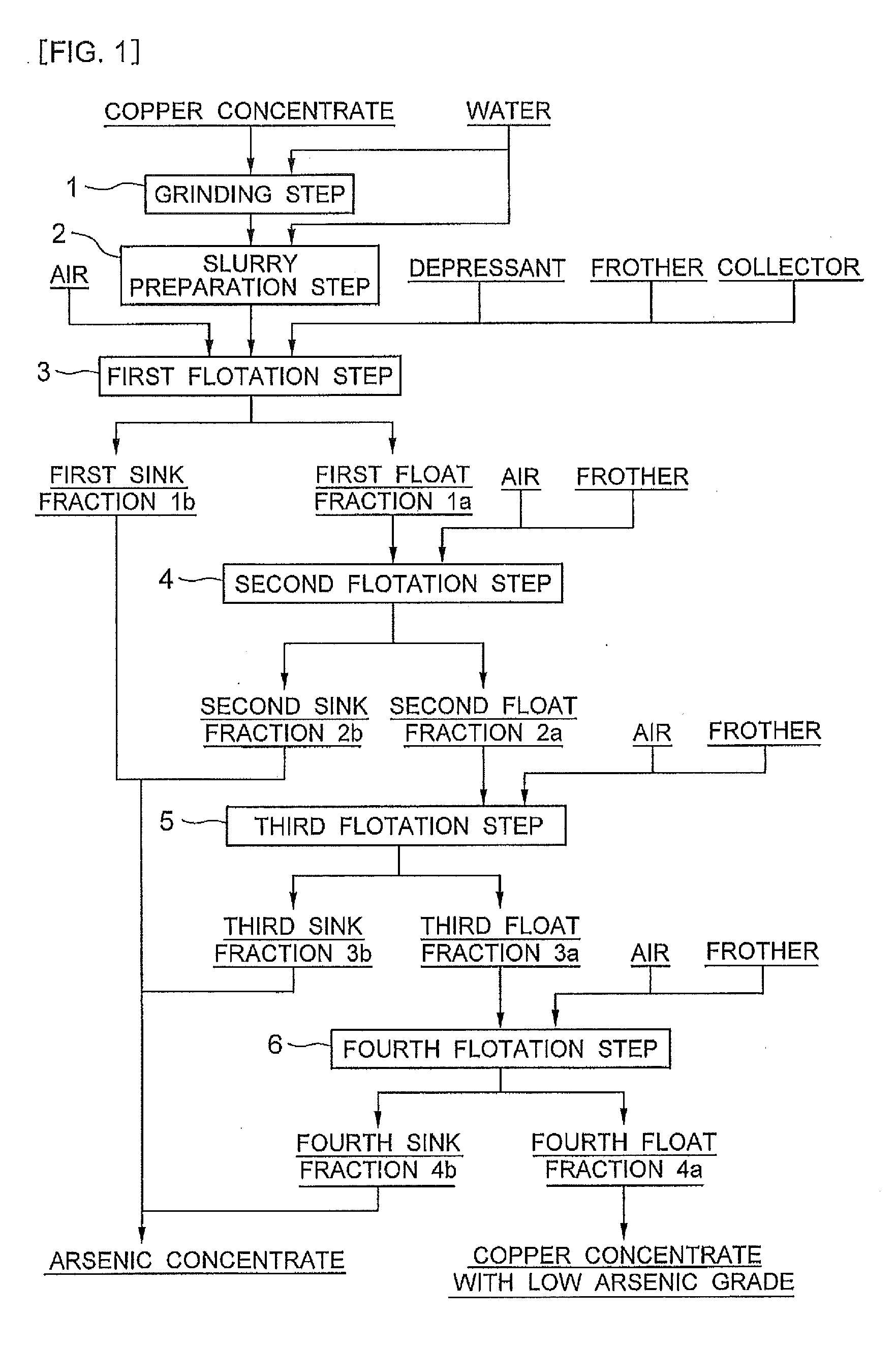Method for separating arsenic mineral from copper-bearing material with high arsenic grade
a technology of arsenic mineral and copper, which is applied in the field of mineral dressing method, can solve the problems of increasing cost, unsatisfactory direct discharge of dust, and inability of existing slag treatment equipment for fixing arsenic to slag, so as to suppress the impact of arsenic on the environment, increase the arsenic processing load, and suppress capital expenditure
- Summary
- Abstract
- Description
- Claims
- Application Information
AI Technical Summary
Benefits of technology
Problems solved by technology
Method used
Image
Examples
examples
[0042]The present invention will be described in more detail with reference to the following examples and comparative examples. However, the present invention is not limited to these examples. For example, in the following examples, a copper-bearing material is processed through four flotation steps, but the number of flotation steps is not limited thereto, and is appropriately determined depending on the properties of a copper-bearing material to be processed, cost effectiveness, etc. It is to be noted that in the following examples and comparative examples, chemical analytical values were determined by ICP emission spectrometry and the mineral composition of a copper-bearing material to be processed was determined by observation with a microscope. As a copper-bearing material, a copper concentrate of Peru origin was used. The chemical analytical values and mineral composition of the copper concentrate are shown in the following Table 1.
TABLE 1Chemical Analytical Value (wt %)Minera...
examples 1 to 4
[0043]In Example 1, the copper concentrate of Peru origin shown in the above Table 1 was subjected to flotation according to a flow diagram shown in FIG. 1 to obtain a copper concentrate with low arsenic grade and an arsenic concentrate. More specifically, 100 g of the copper concentrate of Peru origin (sample A) shown in the above Table 1 was mixed with 100 ml of water and ground by a ball mill so that an 80%-pass particle size of 25 μm was achieved (grinding step 1). The thus obtained ground product was mixed with water to prepare a slurry having a total weight of 500 g and a volume of 400 ml (slurry preparation step 2). This slurry was charged into an Agitair type flotation test machine having a cell volume of 0.5 L, and then agitation was started.
[0044]Then, TETA (triethylenetetramine) was added as a depressant for suppressing the flotation of an arsenic mineral in an amount of 0.24 g corresponding to 2.4 kg per ton of the copper concentrate. The amount of the depressant added w...
examples 5 to 9
[0049]In Examples 5 to 7, flotation was performed in the same manner as in Example 1 except that the chelator was changed from TETA to EDTA (ethylenediaminetetraacetic acid) and the amount of the chelator added was changed to 5 to 20 equivalents. In Examples 8 and 9, flotation was performed in the same manner as in Example 1 except that the chelator was changed from TETA to 8 equivalents of PEHA (pentaethylenehexamine) or CyDTA (cyclohexanediaminetetraacetic acid) and the pH of the slurry was adjusted to about 5.8 with sulfuric acid.
PUM
| Property | Measurement | Unit |
|---|---|---|
| Equivalent mass | aaaaa | aaaaa |
| Volume | aaaaa | aaaaa |
| Volume | aaaaa | aaaaa |
Abstract
Description
Claims
Application Information
 Login to View More
Login to View More - R&D
- Intellectual Property
- Life Sciences
- Materials
- Tech Scout
- Unparalleled Data Quality
- Higher Quality Content
- 60% Fewer Hallucinations
Browse by: Latest US Patents, China's latest patents, Technical Efficacy Thesaurus, Application Domain, Technology Topic, Popular Technical Reports.
© 2025 PatSnap. All rights reserved.Legal|Privacy policy|Modern Slavery Act Transparency Statement|Sitemap|About US| Contact US: help@patsnap.com



